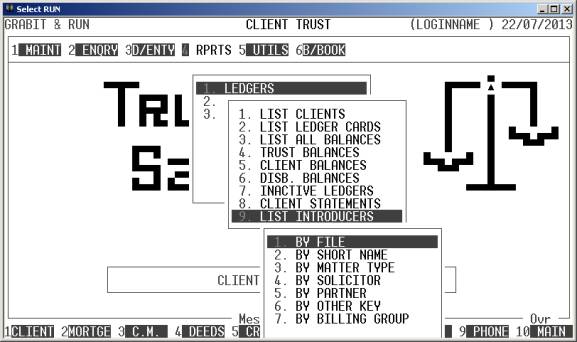Total
Legal Accounting 3
SECTION
1.4.1.9 – LIST INTRODUCERS
USAGE: This is a special report for sites that use the
Introducer function As an aid to cross referencing Files against Introducers, this
report is a simple list of File with their Client name and Matter-re and the
Introducer associated with them. This allows you to quickly tick off the Files
to make sure that they are correctly specified. This information can also be
gleaned from an ASCII export, but some Sites prefer a paper copy.
DISCUSSION: When you choose this option, the screen will
appear as follows:

Here you can choose the order in which you wish to
print the report.
Hint: If you intend to limit the report to a range of
files, it is most efficient to print the report in the same order. Eg if you
wish to limit the report to a range of file codes, the report will scan the
master-file faster if you also print the report in file order.
Having chosen from the options, the following
questions will appear:
USE LONG FORMAT REPORT If you are using wide stationery, reply Y, otherwise reply N. This question will only be
displayed if the relevant option is set to A, see SECTION 7.1.2.
START A NEW PAGE ON
CHANGE OF KEY If you have chosen to print
the report in Matter-type, Solicitor, Partner, Other-key or Billing-Group
order, you will be offered this option. If you reply Y, T.L.A. will start a new page each time the major key changes. A sub-total
will also be printed for each group of transactions. If you reply N, the transactions will be printed continuously.
INCLUDE ALL FILES If you answer Y here, all Client files will
be printed and no further “limits” questions will be asked. Go directly to the OK TO PRINT question. If you answer N, the following question asks you to enter both a lower and upper
limit. The upper limit must not be less than the lower limit. The default
answers define the extreme limits of the field. You do not have to change all
of these limits. Only change the ones you wish to, and tab past the others.
INCLUDE UNCOMPLETED FILES If you answer N here, any open
Client files will not be included in the report.
INCLUDE COMPLETED FILES If you answer N here, any closed
Client files will not be included in the report.
FILE RANGE This is the Client’s code.
SHORT NAME RANGE This is the upper and lower limits of the first 10 characters
of the Client’s name. It corresponds to the search pattern in CLIENT
ENQUIRIES (see SECTION 1.1).
MATTER-TYPE RANGE This is the upper and lower limits of the Matter-Type.
SOLICITOR RANGE This is the upper and lower limits of the Solicitor code
as it appears on the Client’s file.
PARTNER RANGE This is the upper and lower limits of the Partner code as it
appears on the Client’s file.
BILLING GROUP RANGE This is the upper and lower limits of the Billing-group code as it
appears on the Client’s file. Note that the Billing-group may by blank. To print
files that have a Billing-group only, enter the lower limit of a and the upper limit of zzz.
ASSOCIATE RANGE This is the upper and lower limits of the Associate code
as it appears on the Client’s file. Note that the Associate may by blank. To
print files that have an Associate only, enter the lower limit of a and the upper limit of zzz.
INTRODUCER RANGE This is the upper and lower limits of the Introducer code as
it appears on the Client’s file.
OTHER KEY RANGE This may appear as a different literal depending on how
you have defined the field in SYSTEM
PARAMETERS.
TRUST BALANCE RANGE This is the current Trust balance.
CLIENT BALANCE RANGE This is the current total Client balance.
DISB. BALANCE RANGE This is the current Disbursement balance.
S&I BALANCE RANGE This is the current Investment balance.
DATE CREATED RANGE This is the date the file was created.
DATE LAST MOVEMENT RANGE This is the last Trust movement date.
In all cases, the default answers are the extreme limits
of each range, so if you do not wish to limit the report on a particular field,
just bypass it.
To start the report, press <Enter> through each field or simply press <F10>.
The report will scan the Client master-file and
extract all records that fit within your chosen parameters. The report itself
will detail the File code, Name, Matter Re, Matter code (long format only) and
Introducer code.